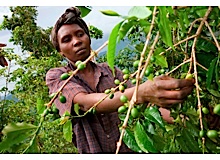
A large literature exists on commercialisation — broadly defined as having greater engagement with markets, either for inputs, outputs, or both — of small, family farms.
Studies and reviews address the following questions:
- Under what conditions, and with what encouragement from policy, may small farms be commercialised? Is it sufficient to provide roads and physically connect farmers to market?
- Does commercialisation benefit smallholding households? Does this improve or worsen food security? How does this affect the position of females within the household?
- Does commercialisation lead to loss of land for small farmers? Does it lead to increased social differentiation of the peasantry? Does it lead to loss of independence, and increasing dependency on private corporations able to exercise monopoly power to take the lion’s share of the benefits?
- Does commercialisation raise risks in the markets to unacceptable levels? Do different abilities to bear risk mean that some farmers can take the opportunities while others dare not?
- What is the impact of commercialisation on those with little or no land? Are they marginalised, or do they benefit through labour markets and other linkages in the rural economy?
- Does commercialisation lead to over-use of natural resources or otherwise degrade the environment?
In the broadest terms, there are two answers to the above questions. The first and most obvious answer is that it all depends. So many factors mediate the impacts of the varying forms and degrees of commercialisation, that it is possible to observe all manner of outcomes.
The second reply would be that most of the overviews [e.g. von Braun et al., Leavy & Poulton, Jaleta et al.] are cautiously optimistic about the feasibility and desirability of commercialisation. There are enough cases of positive changes to argue that encouraging commercialisation can be effective in most developing countries.
The initial findings from the village studies carried out so far under FAC, plus those by SUA Morogoro, confirm the latter conclusion: small farms can successfully commercialise. There are even suggestions from the labour statistics that however uneven the process may be, there may be wider benefits in the local economy.
Future Work
Two broad sets of questions may be addressed by future FAC work:
- What are the dynamics seen in farming systems and local rural economies in communities where small farmers are commercialising? And, more specifically,
- How strong are the resulting multipliers in the local rural economy? How do they compare to what might be expected from comparable larger-scale agricultural development?
{jcomments off}

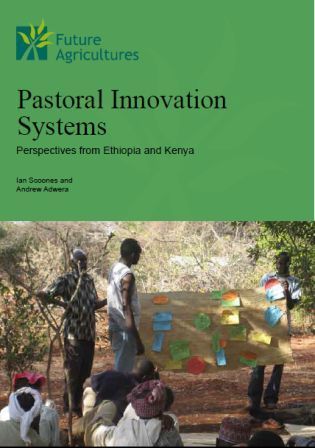

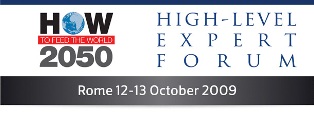 12-13 October 2009 The Global Forum on Food Security and Nutrition (FSN FORUM) hosted the online-discussion
12-13 October 2009 The Global Forum on Food Security and Nutrition (FSN FORUM) hosted the online-discussion 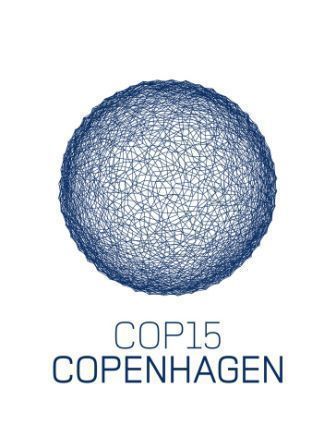
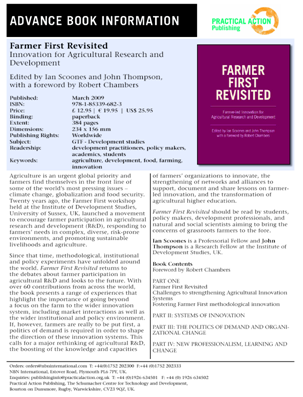 world’s most pressing issues – climate change, globalization and food security.Twenty years ago, the Farmer First workshopheld at the Institute of Development Studies,University of Sussex, UK, launched a movement to encourage farmer participation in agriculturalresearch and development (R&D), responding to farmers’ needs in complex, diverse, risk-proneenvironments, and promoting sustainable livelihoods and agriculture.Since that time, methodological, institutional and policy experiments have unfolded aroundthe world. Farmer First Revisited returns to the debates about farmer participation inagricultural R&D and looks to the future. With over 60 contributions from across the world,the book presents a range of experiences that highlight the importance of going beyonda focus on the farm to the wider innovation system, including market interactions as well asthe wider institutional and policy environment. If, however, farmers are really to be put first, apolitics of demand is required in order to shape the direction of these innovation systems.
world’s most pressing issues – climate change, globalization and food security.Twenty years ago, the Farmer First workshopheld at the Institute of Development Studies,University of Sussex, UK, launched a movement to encourage farmer participation in agriculturalresearch and development (R&D), responding to farmers’ needs in complex, diverse, risk-proneenvironments, and promoting sustainable livelihoods and agriculture.Since that time, methodological, institutional and policy experiments have unfolded aroundthe world. Farmer First Revisited returns to the debates about farmer participation inagricultural R&D and looks to the future. With over 60 contributions from across the world,the book presents a range of experiences that highlight the importance of going beyonda focus on the farm to the wider innovation system, including market interactions as well asthe wider institutional and policy environment. If, however, farmers are really to be put first, apolitics of demand is required in order to shape the direction of these innovation systems. 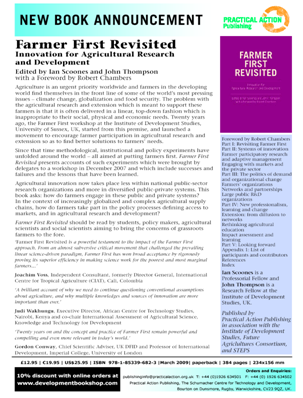 front line of some of the world’s most pressing issues – climate change, globalization and food security. The problem with the agricultural research and extension which is meant to support these farmers is that it is often delivered in a linear, top-down fashion which is inappropriate to their social, physical and economic needs. Twenty years ago, the Farmer First workshop at the Institute of Development Studies, University of Sussex, UK, started from this premise, and launched amovement to encourage farmer participation in agricultural research andextension so as to find better solutions to farmers’ needs.Since that time methodological, institutional and policy experiments have unfolded around the world – all aimed at putting farmers first. Farmer First Revisited presents accounts of such experiments which were brought by delegates to a workshop in December 2007 and which include successes and failures and the lessons that have been learned.
front line of some of the world’s most pressing issues – climate change, globalization and food security. The problem with the agricultural research and extension which is meant to support these farmers is that it is often delivered in a linear, top-down fashion which is inappropriate to their social, physical and economic needs. Twenty years ago, the Farmer First workshop at the Institute of Development Studies, University of Sussex, UK, started from this premise, and launched amovement to encourage farmer participation in agricultural research andextension so as to find better solutions to farmers’ needs.Since that time methodological, institutional and policy experiments have unfolded around the world – all aimed at putting farmers first. Farmer First Revisited presents accounts of such experiments which were brought by delegates to a workshop in December 2007 and which include successes and failures and the lessons that have been learned. 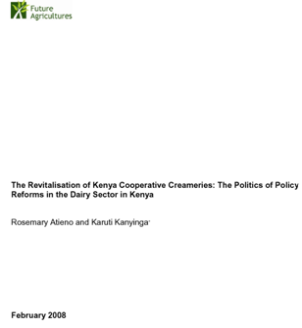 particular reference to the Kenya Cooperative Creameries (KCC). It is developed for the Policy Processes sub theme of the Future Agricultures Consortium (FAC). The sub theme recognizes that that while many policy recommendations on how to get agriculture moving have been made, too often such recommendations have foundered. This has been attributed to among other things, the narrow focus on the technical dimensions of policy, with little attention paid to the political economy and the complex politics of policy making in specific contexts (FAC 2007).
particular reference to the Kenya Cooperative Creameries (KCC). It is developed for the Policy Processes sub theme of the Future Agricultures Consortium (FAC). The sub theme recognizes that that while many policy recommendations on how to get agriculture moving have been made, too often such recommendations have foundered. This has been attributed to among other things, the narrow focus on the technical dimensions of policy, with little attention paid to the political economy and the complex politics of policy making in specific contexts (FAC 2007).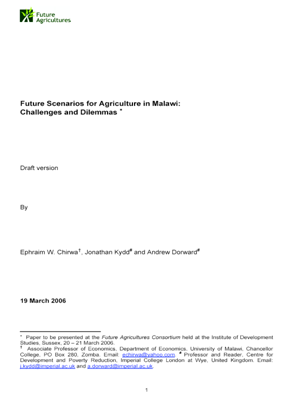 Malawi is one of the poorest countries in the world with per capita gross domestic product of $190, 30 percent of under-five children being malnourished and the infant mortality rate of 229 per 1,000 live births and a life expectancy at birth of 42 years (World Bank, 2001). Data from a recent household survey shows that about 52.4 percent of the population lived below the poverty line, with 22.4 percent barely surviving in 2004 (NSO, 2005). There are gender differences in food insecurity with 62.9 percent of female-headed households and 54.6 percent of male-headed households reporting inadequate food consumption.
Malawi is one of the poorest countries in the world with per capita gross domestic product of $190, 30 percent of under-five children being malnourished and the infant mortality rate of 229 per 1,000 live births and a life expectancy at birth of 42 years (World Bank, 2001). Data from a recent household survey shows that about 52.4 percent of the population lived below the poverty line, with 22.4 percent barely surviving in 2004 (NSO, 2005). There are gender differences in food insecurity with 62.9 percent of female-headed households and 54.6 percent of male-headed households reporting inadequate food consumption.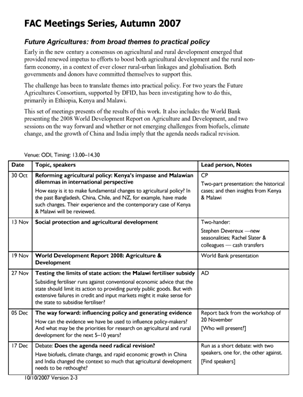
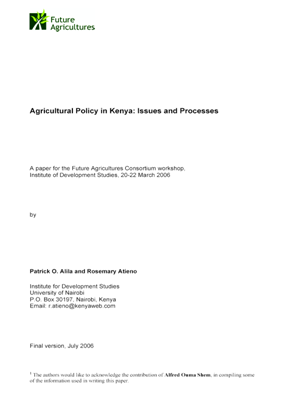 Agriculture remains the backbone of the Kenyan economy. It is the single most important sector in the economy, contributing approximately 25% of the GDP, and employing 75% of the national labour force (Republic of Kenya 2005). Over 80% of the Kenyan population live in the rural areas and derive their livelihoods, directly or indirectly from agriculture.
Agriculture remains the backbone of the Kenyan economy. It is the single most important sector in the economy, contributing approximately 25% of the GDP, and employing 75% of the national labour force (Republic of Kenya 2005). Over 80% of the Kenyan population live in the rural areas and derive their livelihoods, directly or indirectly from agriculture. 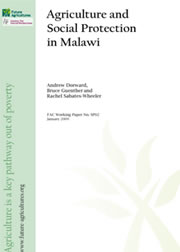 This paper reviews social protection and agriculture policies in Malawi in order to explorethe links, synergies and conflicts that lie between them. It begins with brief backgroundinformation about Malawi, in terms of its economic and welfare indicators.
This paper reviews social protection and agriculture policies in Malawi in order to explorethe links, synergies and conflicts that lie between them. It begins with brief backgroundinformation about Malawi, in terms of its economic and welfare indicators.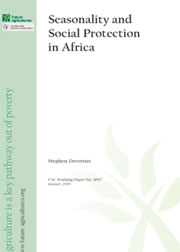 This Working Paper draws on nearly twenty years of research in several African countries,on the inter-related themes of food insecurity, seasonality, coping strategies, famine, form a land in formal safety nets, and social protection. The paper has three objectives:
This Working Paper draws on nearly twenty years of research in several African countries,on the inter-related themes of food insecurity, seasonality, coping strategies, famine, form a land in formal safety nets, and social protection. The paper has three objectives: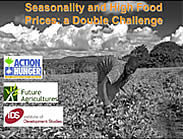 1. Seasonal hunger is predictable, can be understood and there are tested solutions
1. Seasonal hunger is predictable, can be understood and there are tested solutions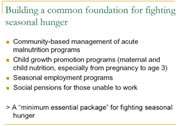 Community-based management of acutemalnutrition programs
Community-based management of acutemalnutrition programs 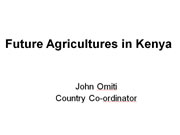 Cross-country co-ordination issues
Cross-country co-ordination issues 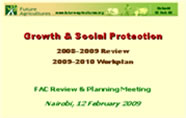 OUTPUTS (1): Working Paper series
OUTPUTS (1): Working Paper series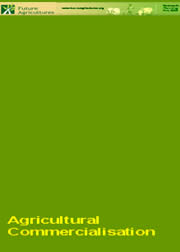 Aim:
Aim: 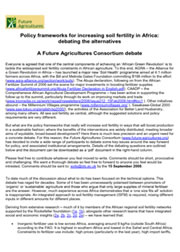 Everyone is agreed that one of the central components of achieving an „African Green Revolution. is totackle the widespread soil fertility constraints in African agriculture. To this end, AGRA – the Alliance fora Green Revolution in Africa – has launched a major new „Soil Health. programme aimed at 4.1 millionfarmers across Africa, with the Bill and Melinda Gates Foundation committing $198 million to the effort
Everyone is agreed that one of the central components of achieving an „African Green Revolution. is totackle the widespread soil fertility constraints in African agriculture. To this end, AGRA – the Alliance fora Green Revolution in Africa – has launched a major new „Soil Health. programme aimed at 4.1 millionfarmers across Africa, with the Bill and Melinda Gates Foundation committing $198 million to the effort 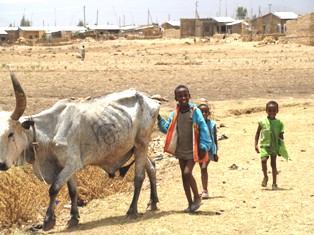 Youth’s inclination toward agriculture and future farmers was highlighted in regional consultations. Schools children were asked to describe their homes in the past present and future. We put the images that children created on display. Their views far surpassed their age.
Youth’s inclination toward agriculture and future farmers was highlighted in regional consultations. Schools children were asked to describe their homes in the past present and future. We put the images that children created on display. Their views far surpassed their age.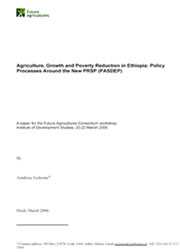 “Agriculture is the mainstay of the Ethiopian Economy”. This statement has almost become acliché for development professionals in Ethiopia. Those who went to school 50 years ago,read it; and later on wrote about it. So has the present generation. The Report on the Ethiopian Economy, Volume IV (EEA/EEPRI, 2004/05:10) stated, for example:“…agriculture is the main stay of the Ethiopian economy and the most volatile sector….mainly due to its dependence on rain and the seasonal shocks that are frequently observed”.
“Agriculture is the mainstay of the Ethiopian Economy”. This statement has almost become acliché for development professionals in Ethiopia. Those who went to school 50 years ago,read it; and later on wrote about it. So has the present generation. The Report on the Ethiopian Economy, Volume IV (EEA/EEPRI, 2004/05:10) stated, for example:“…agriculture is the main stay of the Ethiopian economy and the most volatile sector….mainly due to its dependence on rain and the seasonal shocks that are frequently observed”.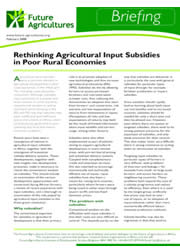 Agricultural input subsidies were a common element in agricultural development in poor rural economies in the 1960s and 70s, including successful green revolutions. Although subsidies have continued, to a greater and lesser extent, in some countries, conventional wisdom as well as dominant donor thinking in the 80s and 90s was that subsidies had been ineffective and inefficient policy instruments in Africa, which contributed to government overspending and fiscal and macroeconomic problems.
Agricultural input subsidies were a common element in agricultural development in poor rural economies in the 1960s and 70s, including successful green revolutions. Although subsidies have continued, to a greater and lesser extent, in some countries, conventional wisdom as well as dominant donor thinking in the 80s and 90s was that subsidies had been ineffective and inefficient policy instruments in Africa, which contributed to government overspending and fiscal and macroeconomic problems.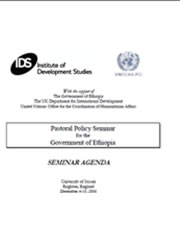 Professor Jeremy Swift specialises in the development of pastoral economiesin Africa, the Middle East and Central Asia. His particular interests include;
Professor Jeremy Swift specialises in the development of pastoral economiesin Africa, the Middle East and Central Asia. His particular interests include; 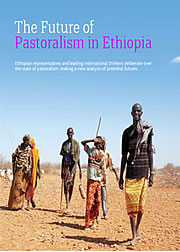 Ethiopian representatives and leading international thinkers deliberate overthe state of pastoralism, making a new analysis of potential futures Understanding of Pastor Pastoralism alismEthiopia has Africa’ Africa’s largest livestock population. Over 60% of its land area iss semi-arid lowland, dominated by the livestock economy economy.
Ethiopian representatives and leading international thinkers deliberate overthe state of pastoralism, making a new analysis of potential futures Understanding of Pastor Pastoralism alismEthiopia has Africa’ Africa’s largest livestock population. Over 60% of its land area iss semi-arid lowland, dominated by the livestock economy economy.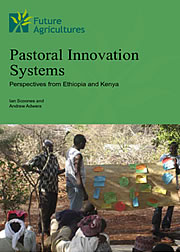 The Future Agricultures Consortium (FAC) aims to encourage critical debate and policy dialogue on the future of agriculture in Africa. The Consortium is a partnership between research-based organisations in Africa and the UK, with work currently focusing on Ethiopia, Kenya and Malawi.Through stakeholder-led policy dialogues on future scenarios for agriculture, informed by field research, the Consortium aims to elaborate the practical and policy challenges of establishing and sustaining pro-poor agricultural growth in Africa, with a focus onEthiopia, Kenya and Malawi.Current work focuses on four core themes:
The Future Agricultures Consortium (FAC) aims to encourage critical debate and policy dialogue on the future of agriculture in Africa. The Consortium is a partnership between research-based organisations in Africa and the UK, with work currently focusing on Ethiopia, Kenya and Malawi.Through stakeholder-led policy dialogues on future scenarios for agriculture, informed by field research, the Consortium aims to elaborate the practical and policy challenges of establishing and sustaining pro-poor agricultural growth in Africa, with a focus onEthiopia, Kenya and Malawi.Current work focuses on four core themes: